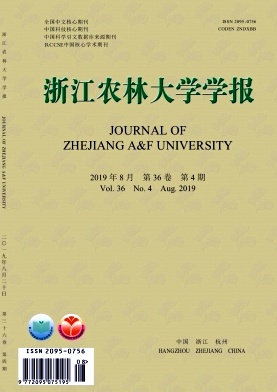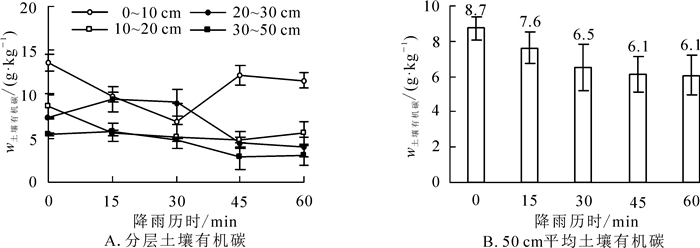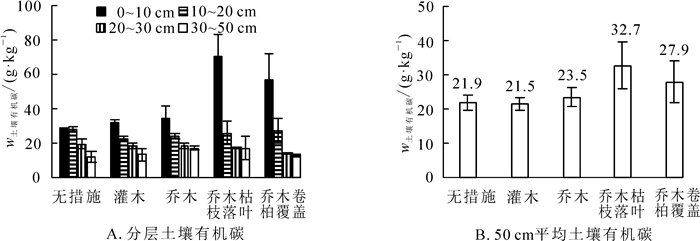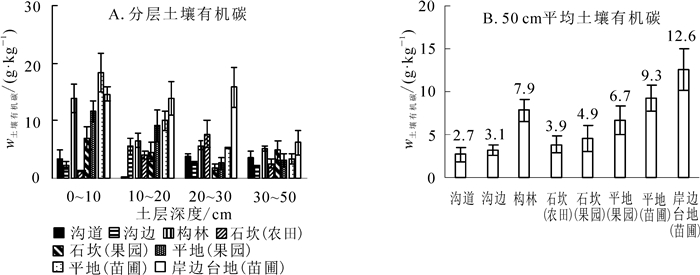-
联合国政府间气候变化专门委员会(IPCC)2007年报告指出,全球未来平均降水强度和降水量将继续变化。经模型预测,随着全球气候变化,降雨格局也将发生改变,其中单次降雨量的增大意味着干旱半干旱地区极端降雨事件将会增加[1]。土壤作为地球表层最大的有机碳库,其二氧化碳(CO2)排放是大气CO2的重要来源,在全球碳循环中起着至关重要的作用,土壤碳库的微小变化都会在很大程度上影响大气CO2浓度的变化。而水蚀是引起土壤有机碳流失及影响有机碳矿化速率的重要因素之一。随着全球极端降雨事件的持续增加,水蚀成为引发土壤退化的一个重要因素[2],土壤侵蚀将影响全球碳循环和碳平衡[3]。土壤中的有机碳以粗有机碳、细颗粒状有机碳和与土壤矿物质的结合态存在,而且粗颗粒有机碳相对来说容易移动[4]。土壤受到侵蚀时,粗颗粒易被破坏,导致土壤有机碳的释放。侵蚀造成土壤中有机碳的损失包括随径流移走的可溶性有机碳和与黏粒结合的有机碳以及有机残体的碎屑[5]。水蚀主要通过雨滴的击溅作用和径流的剥蚀作用引起侵蚀区土壤有机碳的流失。随着研究的深入,有关学者认为,水蚀虽然造成侵蚀区有机碳减少,但在沉积区有机碳富集[3, 6-7]。水蚀是一个无处不在的过程,但其对全球碳循环过程的影响依然存在很大的不确定性,其如何影响土壤中各层次有机碳的含量,不同水土保持工程及植物措施对土壤有机碳的保护起到怎样的作用?这些都是学术界很关心的问题,然而在很大程度上仍然没有答案[8-9]。土壤侵蚀对土壤碳循环和碳平衡的影响是全球变化研究的前沿领域之一,合理认识水蚀对土壤有机碳排放的影响具有重要意义。目前,国内关于水蚀及水土保持措施对土壤有机碳影响的研究还不多,主要集中于黄土高原区及南方红壤区,例如贾松伟[10]对黄土丘陵区不同坡度下土壤有机碳流失规律进行了研究,认为土壤有机碳流失的变化趋势与侵蚀强度一致, 有机碳流失主要受侵蚀强度的影响,减少地表径流和土壤侵蚀是降低土壤有机碳流失的关键;刘学彤等[11]对黄土高原水蚀风蚀交错带不同退耕模式对土壤有机碳的影响进行了研究,结果表明:不同退耕模式均能提高0~10 cm土层土壤有机碳含量,表明农地退耕、植被恢复与重建可以减少水土流失并显著增加土壤固存碳的能力;陆银梅等[12]就红壤缓坡地径流对土壤有机碳流失的影响进行了研究,结果表明:坡面产流过程对泥沙态有机碳流失过程具有明显影响,产流开始后,有机碳流失率随降雨历时延长而增加,而后逐步趋于平稳;肖胜生等[1]研究了自然降雨条件下红壤坡面有机碳的选择性迁移,认为径流有机碳含量与径流量之间、泥沙含碳量与泥沙量之间均呈负相关关系,即随着土壤侵蚀模数的降低,有机碳富集比也减小,泥沙有机碳富集比均随雨强的增大而减小;王义祥等[13]分析了经过水保措施处理的油桃Prunus persica var. nectarina园土壤有机碳库及其组分,得到结论为相对顺坡开垦,长期采用梯台开垦方式有利于增加果园土壤有机碳库,生草处理加速了土壤有机质的转化,从而使果园土壤中颗粒有机碳、轻组有机碳和水溶性有机碳均有增加。目前,北方土石山区自然及人工林地水蚀对土壤有机碳影响的研究还未见报道,而典型水土保持措施对土壤有机碳影响的相关研究也相对较少。本研究在北京周边土石山区选择有代表性的水蚀及水土保持措施典型样地,开展野外不同降雨历时的原位人工降雨模拟试验,对水蚀及水土保持措施对土壤有机碳的影响进行研究。期望本研究可为北方土石山区水土保持措施的选择及水土流失治理提供借鉴。
HTML
-
在北京周边土石山区分别选择有代表性的水蚀及水土保持措施典型样地。水蚀样地分别选取了油松Pinus tabulaeformis-侧柏Platycladus orientalis混交林坡面及油松-槲栎Quercus aliena混交林坡面。其中,油松-侧柏混交林地供采样的坡面,坡向为阳坡,坡度31°,为自然林地覆盖的沟道边坡。坡顶植被郁闭度约40%,侵蚀类型为雨滴击溅侵蚀及细沟状侵蚀;坡中植被郁闭度约70%,侵蚀类型主要为细沟状侵蚀;坡底为沟道,郁闭度约35%,侵蚀类型为强度较大的冲刷性侵蚀;平地对照样地郁闭度70%,侵蚀较弱,只存在雨滴击溅侵蚀。油松-槲栎混交林供采样坡面为自然坡面,坡向为西南半阳坡,坡度19°,坡顶主要为溅蚀与细沟侵蚀;坡中主要为溅蚀及较坡顶更为剧烈的细沟侵蚀;坡底地势较为平缓,基本不发生侵蚀,并有一定土壤堆积,该坡面植被郁闭度较低,约为10%;平地对照样地郁闭度10%,侵蚀较弱,只存在雨滴击溅侵蚀。水土保持措施样地分别选择了不同植物配置鱼鳞坑(无植被鱼鳞坑、灌木鱼鳞坑、乔木鱼鳞坑、有枯枝落叶乔木鱼鳞坑、中华卷柏Selaginella sinensis鱼鳞坑、不同配置石坎梯田(石坎农田、石坎果园)及不同配置水土保持经济林(岸边台地苗圃、平地苗圃、平地果园)及严重侵蚀沟道对照样地。样地均位于同一流域,其中侵蚀沟道宽度10 m左右,深度2.5 m,平时沟道中无流水。分别在沟道沟底、沟道边坡1.5 m处及沟道和沟道上部台地人工林进行土壤取样。沟底及沟边土壤砾石含量极高,达90%以上,两处常年遭受剧烈冲刷性侵蚀;沟林(沟边林地),种植树种为火炬树Rhus typhina,郁闭度较大,约95%,侵蚀类型主要为轻微溅蚀。农田石坎种植作物为玉米Zea mays,果园石坎种植树种为樱桃Cerasus tomentosa,果园平地种植树种为桃树Amygdalus persica,苗圃平地种植树种为油松,苗圃岸边台地种植树种为白蜡Fraxinus chinensis及檞树Quercus dentata。样地土壤类型为山地淋溶褐土,样地土壤质地见表 1,土壤基本理化性质详见表 2。
土层/cm 不同土壤质地百分比/% 砂粒 粉粒 黏粒 0~10 62.73 27.34 9.93 10~20 48.30 40.72 10.98 20~30 34.53 50.75 14.72 30~50 28.30 55.97 15.73 Table 1. Soil texture of sample plot
土壤容重/(g·cm-3) 土壤总孔隙度/% 土壤体积含水率/% 土壤相对含水率/% pH 土壤碱解氮/(mg·kg-1) 土壤有效磷/(mg·kg-1) 土壤速效钾/(mg·kg-1) 1.09~1.41 40.11~48.23 3.85~6.73 3.83~7.93 6.5~7.1 92.43~140.56 1.12~8.06 92.67~157.31 Table 2. Soil physical and chemical properties of sample plots
-
在样地对水蚀影响下各样地进行土壤采样,其中坡面样地分为上、中、下坡位,每个坡位选取3个样点,进行土壤样本采集,并在油松-侧柏混交林坡面布设2处植被情况相似的10 m × 10 m样地,采用自制喷头进行人工降雨模拟,分别进行15,30,45,60 min等4种不同历时相同雨强人工降雨,另设1组无降雨空白对照。实验分2 d进行,每天进行1个样地降雨,因模拟降雨范围较小,不同降雨历时样点间不会相互影响,每个降雨样点随机布设3处侵蚀针,降雨结束后30 min对侵蚀针进行读数记录并进行土壤样本采集(双份)。对于不同水土保持措施样地,每种措施随机选取3个样点进行土壤样本采集。试验在2017年7-8月进行,样地采样点蛇形分布,做到尽量均匀和随机。采样前进行土壤表面清理,尽量去除低矮植物及枯枝落叶覆盖。每个样点挖取深度为50 cm的土壤剖面,分4层采样(0~10,10~20,20~30,30~50 cm),每层采样约500 g,装进塑封袋并标号。土样带回室内进行自然风干、研磨、过筛等处理,土壤有机碳测定采用重铬酸钾氧化-分光光度法(HJ 615-2011)。
-
采用Excel 2010进行数据整理分析与图表制作,应用SPSS 19.0及SigmaPlot 12.0等进行数据统计分析、相关性分析、线性回归分析,并应用最小显著性差异(LSD)多重比较在0.05的显著水平上进行显著性检验,分析总结不同条件下土壤有机碳质量分数规律。
1.1. 样地选择
1.2. 实验方法
1.3. 数据处理与分析
-
图 1可以看出:油松-侧柏混交林除坡底外所有坡位土壤有机碳质量分数随土层加深均呈递减趋势,符合总有机碳垂直分布的特征[14],其中0~10 cm土层有机碳质量分数从大到小依次为平地、坡中、坡顶和坡底,并且各坡位差值较大,差距比较明显,坡顶与坡底土壤有机碳质量分数明显较少,平地数值达到坡底数值的2.56倍;10~20 cm土层有机碳质量分数从大到小依次为坡中、坡顶、平地和坡底,但坡中、坡顶与平地之间数值相差不明显,而坡底数值则相差较为明显;30~50 cm土层有机碳质量分数从大到小依次为坡中、坡底、坡顶和平地,其中坡底与坡顶数值相差较小,坡中最高,平地最低且相差比较明显。可见,平地土壤各层有机碳差别最大,坡底各层差别则较小。

Figure 1. Soil organic carbon content in different slope positions of Platycladus orientalis and Pinus tabulaeformis mingled forests
0~10 cm土层各坡位土壤有机碳质量分数差异显著(P<0.05),其中坡底与其他坡位均存在显著差异(P<0.05),坡顶与平地也存在显著差异(P<0.05);10~20 cm土层仅坡底与其他坡位均存在显著差异(P<0.05);30~50 cm土层坡顶、坡中、坡底土壤有机碳质量分数之间均无显著差异,而平地与另外3个坡位均存在显著差异(P<0.05)。不同坡位土壤50 cm平均土壤有机碳质量分数从大到小依次为坡中、平地、坡顶和坡底。其中坡顶、坡中、平地数值相差不大,而坡底有机碳则明显低于其他3处,差异较大。
由图 2可以看出:油松-槲栎混交林土壤平地及坡底有机碳质量分数随土层加深均呈递减趋势,坡中与坡顶20~30 cm土层有机碳质量分数小于30~50 cm。其中0~10 cm及10~20 cm土层有机碳质量分数从大到小依次为坡底、平地、坡顶和坡中。其中平地数值略低于坡底,坡顶及坡中则与之相差较多;20~30 cm及30~50 cm土层有机碳质量分数从大到小依次为坡底、平地、坡顶和坡中,其中坡底与平地土壤有机碳相差极小,与坡顶及坡中数值相差较大。水蚀比较严重的坡顶及坡中与水蚀较轻的平地及有土壤堆积的坡底之间土壤有机碳质量分数均存在显著差异(P<0.05),而坡中与坡顶间,及坡底与平地间则差异不显著。油松-槲栎混交林不同坡位50 cm平均土壤有机碳质量分数从大到小依次为坡底、平地、坡顶和坡中。总体有机碳质量分数与各坡位水蚀强度呈负相关,水蚀强度最大的坡中总体有机碳质量分数最小,有土壤堆积的坡底有机碳质量分数略大于仅存在溅蚀的平地,平地及坡底总有机碳显著高于坡顶及坡中(P<0.05)。

Figure 2. Soil organic carbon content in different slope positions of Quercus aliena and Pinus tabulaeformis mingled forests
对于植被较茂盛、郁闭度较大的自然坡面,水蚀更容易引起上层土壤有机碳质量分数减少,而对20 cm以下土壤有机碳质量分数影响较小[15];对于植被稀疏、郁闭度较小的自然坡面,水蚀对0~50 cm土壤有机碳质量分数均有影响,并且侵蚀越剧烈,有机碳质量分数越低。综合各坡位分析结果,有机碳质量分数从高到低依次为土壤堆积区、轻微溅蚀区、细沟侵蚀区和强烈冲刷侵蚀区[7, 10, 15-16]。
-
由图 3可以看出:10~50 cm土层土壤有机碳质量分数随降雨历时增加(土壤侵蚀量增长)均总体呈减少趋势,而表层0~10 cm土壤则呈先减少后增加趋势。0~10 cm土层土壤在无水蚀发生时,土壤有机碳质量分数最高,降雨历时为15和30 min时,土壤有机碳质量分数持续降低,而随降雨历时增加,土壤有机碳质量分数出现回增现象,并且增加幅度明显;10~20 cm土层土壤有机碳质量分数变化随降雨历时增加(土壤侵蚀量增长)总体呈减少趋势,在降雨历时大于45 min后,有机碳略有回增,但增加趋势并不明显;20~30 cm土层土壤与0~10 cm土层土壤有机碳质量分数变化趋势恰好相反,降雨历时为15和30 min时,土壤有机碳质量分数呈现增加趋势,而随降雨历时增加,土壤有机碳质量分数开始呈减少的趋势;30~50 cm土层土壤有机碳质量分数变化随降雨历时增加(土壤侵蚀量增长)总体呈减少趋势,但变化趋势与其他土层相比较平缓。
由于本研究主要针对极端降雨情况,雨强极大,对土壤侵蚀作用极强,50 cm土壤平均有机碳质量分数随降雨历时增加(土壤侵蚀量增长)呈减少趋势,并且减少趋势随降雨历时增加(土壤侵蚀量增长)逐渐变缓而趋于稳定。
-
由图 4可以看出:不同配置鱼鳞坑土壤有机碳质量分数均随土层加深呈递减趋势。0~10 cm土壤有机碳质量分数从大到小依次为乔木枯枝落叶鱼鳞坑、乔木卷柏覆盖鱼鳞坑、乔木鱼鳞坑、灌木鱼鳞坑和无措施鱼鳞坑,其中乔木枯枝落叶鱼鳞坑及乔木卷柏覆盖鱼鳞坑表层土壤有机碳显著(P<0.05)高于其他3种配置鱼鳞坑,并高于北京地区其他实测自然林地表层土壤平均有机碳质量分数。乔木枯枝落叶鱼鳞坑与乔木卷柏覆盖鱼鳞坑表层土壤有机碳质量分数差值为13.2 g·kg-1,乔木枯枝落叶鱼鳞坑有机碳数值分别为乔木、灌木、无措施鱼鳞坑有机碳数值的2.01,2.20和2.50倍;10~20 cm土壤有机碳质量分数从大到小依次为无措施鱼鳞坑、乔木枯枝落叶鱼鳞坑、乔木卷柏覆盖鱼鳞坑、乔木鱼鳞坑和灌木鱼鳞坑,该层各措施下有机碳质量分数差异不大;乔木卷柏覆盖鱼鳞坑20~30 cm土壤有机碳质量分数最小,其他4项措施该层土壤有机碳相差较小。不同配置鱼鳞坑50 cm土壤平均有机碳质量分数从大到小依次为乔木枯枝落叶鱼鳞坑、乔木卷柏覆盖鱼鳞坑、乔木鱼鳞坑、无措施鱼鳞坑和灌木鱼鳞坑。抗侵蚀能力越强、保水保土能力越强的鱼鳞坑表层土壤有机碳质量分数越高,各土层间有机碳质量分数的差值也越明显。可见不同水保措施对表层土壤有机碳质量分数影响较大。
-
由图 5可以看出:沟道、沟边、农田石坎表层土壤有机碳质量分数明显较低,农田石坎最低。苗圃岸边台地各层土壤有机碳质量分数均较高,该样点地势平坦,土壤侵蚀作用较小,并且土壤肥沃,种植树种均为乔木,有利于水土保持及土壤有机碳的保护。苗圃平地0~20 cm土壤有机碳质量分数较高,而20~50 cm土壤有机碳则处于中等水平。沟边林地各层土壤有机碳质量分数均处于中上水平;在0~30 cm土层内,果园平地土壤有机碳质量分数大于果园石坎,分析其原因为果园石坎修建前,坡地经常发生土壤侵蚀,造成0~30 cm土壤有机碳质量分数较小。
不同水土保持措施50 cm土壤平均有机碳质量分数从大到小依次为岸边苗圃台地、苗圃平地、沟边林地、果园平地、果园石坎、农田石坎、沟边和沟道,其中岸边苗圃台地土壤肥沃,苗圃平地土壤侵蚀微弱,沟边林地植被茂盛,郁闭度高。这3种水土保持措施有机碳质量分数明显高于其他措施,果园平地则略低,处于中等水平,果园石坎、农田石坎土壤有机碳质量分数较低,沟道和沟边土壤有机碳质量分数则最低。
2.1. 水蚀条件下土壤有机碳变化规律
2.1.1. 水蚀条件下不同坡位土壤有机碳变化规律
2.1.2. 水蚀条件下不同降雨历时土壤有机碳质量分数变化规律
2.2. 不同水土保持措施土壤有机碳质量分数对比
2.2.1. 不同配置鱼鳞坑土壤有机碳质量分数对比
2.2.2. 不同水土保持措施土壤有机碳质量分数对比
-
油松-侧柏混交林坡面不同坡位间表层土壤有机碳质量分数差异最为显著(P<0.05),这一结果与王超华[15]的研究一致。分析造成这一现象的原因为水蚀对表层土壤的扰动影响较大,因此表层土壤有机碳损失量较大;油松-槲栎混交林50 cm平均土壤有机碳质量分数从大到小依次为坡底、平地、坡顶和坡中,这一结果与赵鹏志等[17]和孙文义等[18]的研究一致,即土壤有机碳质量分数与水蚀强度大致呈负相关规律。土壤有机碳流失不仅与地形有关,相同地形下不同植被郁闭度等因素也影响土壤有机碳总量及有机碳在土壤各层的分布。今后应关注侵蚀坡面不同植被配置对土壤有机碳层间分布的影响。
在人工模拟降雨试验中,降雨历时为15和30 min时,土壤有机碳质量分数持续降低,而随着降雨历时增加,土壤有机碳出现回增现象,并且增加幅度明显,这与不同土层物化性质不同和淋溶作用有关。这一结果与王茹[19]和方熊等[20]的研究一致。20~30 cm土层土壤有机碳质量分数主要受到淋溶作用影响,在降雨历时小于30 min时,其上层的土壤有机碳组分中的可溶性有机碳通过淋溶作用到达该层,而此时该层土壤并未出现壤中流侵蚀,故该层有机碳质量分数短暂上升;而当降雨时间继续增加,该层水分过多,有机碳矿化速率增加,并开始发生侵蚀情况,有机碳随水土流失而减少。本研究中,降雨对土壤50 cm总有机碳质量分数的影响较为显著(P<0.05),这一结果与陆银梅等[12]的研究一致,主要原因是本研究设置了较大雨强,对土壤产生了极大的冲刷侵蚀作用,所以对深层土壤有机碳的侵蚀作用也较为明显;水蚀主要通过水分增加加速土壤有机碳的矿化作用及土壤侵蚀带走和破坏土壤有机碳组分等途径[3, 21-22],减少有机碳含量[1, 23]。由于各层土壤质地、物化性质和淋溶作用不同,水蚀对不同土层土壤有机碳含量的影响机理尚不明确。
乔木枯枝落叶鱼鳞坑表层土有机碳数值分别为乔木、灌木、无措施鱼鳞坑有机碳数值的2.01,2.20和2.50倍,有机碳极高,这一结果与程曼[24]和黄尚书等[25]的研究结果一致。分析可知:在多种植物措施中,枯枝落叶及腐殖质地表覆盖是大幅增加表层土壤有机碳最有效的方式;在10~20 cm土层中,无措施鱼鳞坑有机碳质量分数较高,灌木鱼鳞坑有机碳质量分数最少,分析原因为鱼鳞坑无植物根系分布,并未消耗该层土壤中有机碳,而灌木在10~20 cm土层根系分布较多,对该层土壤有机碳吸收较多,而相对其他配置鱼鳞坑,灌木对土壤有机碳的返还能力较低,所以灌木鱼鳞坑在该土层有机碳质量分数最少。无措施鱼鳞坑50 cm土层土壤平均有机碳高于灌木鱼鳞坑。分析造成该结果的主要原因为灌木鱼鳞坑土层中有根系分布,对土壤有机碳有吸收作用,而秋季枯枝落叶较少,返还土壤的有机碳较少,使得该措施下土壤有机碳质量分数较低,这一结果与李金芬[26]的研究一致。5种不同配置鱼鳞坑,除种植稀疏灌木外,抗侵蚀能力越强、保水保土能力越强的鱼鳞坑50 cm土层土壤平均有机碳质量分数越高[27]。根据研究结果,建议鱼鳞坑的配置,应注意乔灌草结合,特别是近地表植被配置,应尽量选取枯枝落叶较多的植物种类[24-25, 28],而尽量避免使用单一灌木。
果园石坎、农田石坎土壤在石坎修建前经历长时间侵蚀,致使基础有机碳质量分数较低,并且农田种植作物为玉米,根系较浅,持续消耗土壤中的养分[29],成熟后进行收割,无有机碳返还土壤,造成表层土壤有机碳质量分数较低,该种利用方式对土壤有机碳的积累不利[30];沟边及沟道中,无论小降雨量的溅蚀及淋溶作用,还是大降雨量的冲刷性侵蚀,都会使土壤有机碳质量分数持续降低,长期土壤侵蚀严重,致使土壤贫瘠,有机碳质量分数最低。土壤侵蚀会严重降低土壤有机碳质量分数[3, 31],不同水土保持措施要选取适合的植物进行有机碳的恢复,其中对有机碳恢复作用从大到小依次为人工林、苗圃、果园和农田,这一结果与王海燕等[30]、邓瑞芬等[32]和赵彤等[33]的研究相似。
-
各坡位土壤有机碳质量分数从大到小依次为土壤堆积区、轻微溅蚀区、细沟侵蚀区和强烈冲刷侵蚀区。不同地形,水蚀程度越严重,土壤各层有机碳质量分数差别越小。植被较茂盛、郁闭度较大的自然坡面,土壤侵蚀更易引起上层土壤有机碳减少;而植被稀疏、郁闭度较小的自然坡面,土壤侵蚀对0~50 cm土壤有机碳质量分数均有影响,且水蚀越剧烈,有机碳质量分数越低。水蚀对土壤原位有机碳质量分数有一定的影响,土壤有机碳会随水蚀作用的增强而减少。由于各层次土壤质地、物化性质和淋溶作用不同,水蚀对不同土层土壤有机碳质量分数的影响机理尚不明确。鱼鳞坑配置对土壤有机碳累积从大到小依次为乔木枯枝落叶覆盖、乔木低矮植被覆盖、乔木种植、无措施和灌木。不同植被措施50 cm土层土壤平均有机碳质量分数从大到小依次为人工林、苗圃、果园和农田。






 本站查看
本站查看




 DownLoad:
DownLoad: